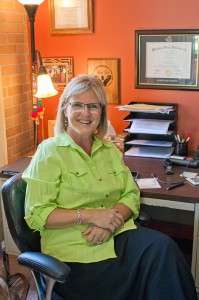Newman School of Education making shifts to prepare students
 By Gina Marx, Ed.D.
By Gina Marx, Ed.D.
Director, School of Education Graduate Program
Who would have thought just three years ago that education would be in the position that it is in today – that 48 states would have voluntarily agreed to share a set of standards for English language arts and literacy and mathematics? This single initiative has the potential to affect the teaching and learning that take place in thousands of classrooms across our state.
Education in Kansas has been rapidly shifting with the approval of Common Core Standards in English Language Arts (ELA) and Literacy, and Mathematics in October 2011 by the Kansas State Board of Education, and more recently for History, Government and Social Studies, as well as the new College and Career Ready Science Standards. The State Board of Education re-named the standards from Common Core State Standards this year to “Kansas College and Career Ready Standards,” but not without controversy. School districts across our state have been transitioning to the standards at various speeds, and the controversy continues with a constituency still working to “undo” this adoption at the legislative level.
However, shifts in the way educators provide instruction are needed because the new standards are very different than the former 2003 State Standards, and the reality is that the standards are currently adopted and approved, so school districts and universities must press forward.
So what are the “shifts” that make the new standards so different for the teachers and children of Kansas? The Kansas State Department of Education (KSDE) has identified three major shifts in ELA and Literacy, and three in Mathematics (see below):
• Building knowledge through content rich nonfiction. Teachers will use a 50-50 balance of informational reading and literary reading to help students build coherent general knowledge both within each year and across years.
• Reading, writing and speaking grounded in evidence from text. Students will use evidence from both informational and literary texts to present careful analyses, well-defended claims, clear information, and answers to a range of text-dependent questions.
• Regular practice with complex text and its academic language. Students will read increasingly complex texts, with a focus on academic vocabulary, to be ready for the demands of college and careers.
Mathematics
• Focus. Through a deeper, more narrow focus on the major work of each grade (subtraction, division, ratios, etc.) students can gain solid conceptual understanding and a high degree of skill and fluency.
• Coherence. By using coherent progressions from grade to grade, students can build new understanding onto foundations built in previous years.
• Rigor. Students should gain conceptual understanding of key concepts, speed and accuracy in calculation, and the ability to apply math in context.
To address these shifts, I have been trained by the KSDE as a trainer for the ELA Common Core, and Associate Professor of Education Joan Purkey, M.E. from our undergraduate department is a trainer for the Mathematics Common Core. Faculty are making “shifts” in their instruction to include preparing our students for all four core areas that our State Board has now approved for Kansas College and Career Ready Standards.
Newman also worked with KSDE this summer to offer three hours of continuing education credit for the KSDE Common Core Academies in five locations across the state. We have also established a national partnership to provide two hours of continuing education credit for a new online course called, “Algebraic Thinking: ITZ the Thought that Counts” that develops skill sets for asking questions to assure student understanding in the new Mathematics Common Core.
For more information, visit
www.commoncoremaththinking.org
and www.corestandards.org.

